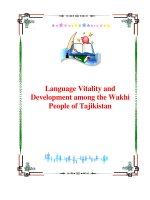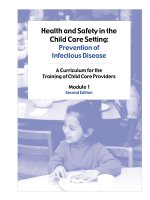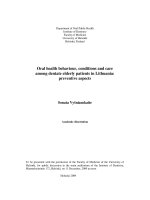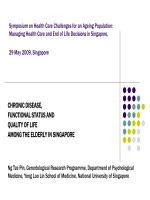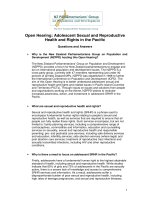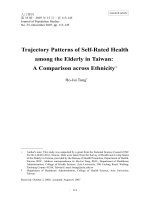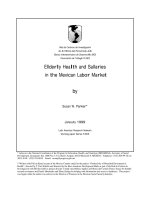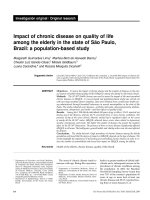Environmental conditions, health and satisfaction among the elderly: Some empirical results potx
Bạn đang xem bản rút gọn của tài liệu. Xem và tải ngay bản đầy đủ của tài liệu tại đây (100.25 KB, 10 trang )
Tra d i t i o n a l ly, age has been used as the major and only determ i-
nant in the process of aging; put another way, age is the causal or ex -
p l a n at o r y va ri able of health, behavior and competence thro u g h o u t
agi n g . Neve rtheless, over recent decades, in seve ral re s e a rch con-
t exts (social ge ro n t o l ogy, human ecology, demograp hy, urban stu-
dies, etc.) there is growing emphasis on the idea that beyond and
behind age (and other biological conditions), social and env i ro n-
mental fa c t o rs account for va ri ation in the way people become older.
As Raphael pointed out «a body of research supports the dis-
tinction between normal, optimal, and pathological aging (Rowe
& Kahn, 1997)). Normal aging is the more frequent process in any
given society; optimal aging occurs under development-enhancing
and age-friendly environmental conditions; sick or pathological
aging is characterized by medical etiology and illness. These dif-
ferences appear to result from contrasts in lifestyle, social support,
socioeconomic status, and other environmental factors” (Raphael,
1996, p.291, underlining added).
Also, several national and international health organizations
(WHO, 1990) have emphasized the importance of environmental
conditions for normal, healthy, and pathological aging for enhan-
cing life satisfaction and quality of life among the elderly. Seve-
ral suggestions have been proposed in order to create positive en-
vironments and implement social programs, but much more rese-
arch must be carried out to increase our knowledge about how and
how much environmental factors influence personal variables.
This article presents evidence supporting the importance of envi-
ronmental variables in health and satisfaction on the elderly.
Person/environment relationships models
As Kurt Lewin (1935) pointed out: there is nothing more prac-
tical than a good theory. Thus, before we introduce any empirical
data about person/environment relationships we must discuss the
most important theories, developed from psychological perspecti-
ves, that try to organize environmental variables and behavioral
and/or psychological characteristics.
Ecological model of competence
Based on Lewin’s field theory of behavior —B=f (P, E, PxE)—
human behavior should be explained by person and environment
Environmental conditions, health and satisfaction among the elderly:
Some empirical results
Rocío Fernández-Ballesteros
Autonoma University of Madrid
Age has been used as the major determinant in the process of aging being the causal or explanatory variable of
health, behavior and competence. Over recent decades, in several research context, there is growing emphasis
on the idea that beyond and behind age (an other biological conditions), external or environmental factors ac-
count for variation in the way people become older. In this article, empirical results coming from several stu-
dies are presented showing the importance of envir
onmental f
actors such as socio-recreational aids, commu-
nity accessibility, expectation of functioning, tolerance, and social climate predict personal factors such as he-
alth, memory and depression complaints, activity, health and satisfaction among the elders living in residential
settings. Also, socio-demographic factors such educational level and income are strongly associated with health
(physical and mental health) and environmental quality seems to be related with life satisfaction in elders li-
ving in the community.
Condiciones ambientales, salud y satisfacción en los mayores: algunos resultados empíricos. La edad ha sido
utilizada como el más importante determinante del proceso de envejecimiento, siendo, además, una variable
causal o explicativa de la salud. En los últimos años, en distintos contextos de investigación, ha existido un cre-
ciente énfasis en la idea de que más allá y más atrás de la edad (y otras condiciones biológicas), factores exter-
nos o ambientales explican las variaciones en las formas de envejecer. En este artículo, se presentan resultados
empíricos procedentes de distintos estudios que muestran la importancia de los factores ambientales tales como
las ayudas socio-recreativas, la accesibilidad a la comunidad, las expectativas de funcionamiento, la tolerancia
y el clima social, predicen factores personales tales como salud, quejas sobre la memoria y la depresión y la sa-
tisfacción entre los viejos que viven en residencias. Asimismo, factores sociodemográficos como la educación
y la renta están fuertemente asociados a la salud (salud física y mental) y la calidad ambiental parece estar, tam-
bién, relacionada con la satisfacción con la vida en personas mayores que viven en la comunidad.
Correspondencia: Rocío Fernández-Ballesteros
Facultad de Psicología
Universidad Autónoma de Madrid
28049 Madrid (Spain)
E-mail:
Psicothema ISSN 0214 - 9915 CODEN PSOTEG
2001. Vol. 13, nº 1, pp. 40-49 Copyright © 2001 Psicothema
conditions as well as by the interaction of these two types of va-
riable. From Lewin’s formula, Lawton (1975, 1982) developed the
Ecological Model of Competence (EMC). Lewin’s formula was
adopted by Lawton, taking the person as competence and the en-
vironment as physical and perceived external demands. As Lawton
pointed out «the term competence represents, to be sure, a limited
aspect of all that might be included in the “P” component of the
ecological equation» (Lawton, 1982, p.35). Competence is defined
as the theoretically highest capacity limit of the individual in
his/her health, sensation, perception, cognitive and motor functio-
ning, and can be assessed in a continuum from high to low level.
Moreover, based on Murray´s theory of environmental press
(Murray, 1938), Lawton (1985) defined environment as the set of
«stimulus or context (which) is seen as having potential demand
character for any individual if empirical evidence exists to de-
monstrate its association with a particular behavioral outcome for
any group of individual» (Lawton 1985, p. 39).
From the EMC model health and behavior can be predicted
from the interaction between level of individual competence and
degree of environmental demands. When the environmental de-
mands are too strong for the subject’s competence level, environ-
ment is a stressor for the individual and negative behavior can be
predicted. But, if the environmental demands are very weak and
the competence level very high, negative results can be derived be-
cause it can be predicted that competence could be extinguish by
not practice. The most favorable environment combines the hig-
hest degree of pressure stimulating the subject’s highest level of
competence, and on the basis of the «docility hypothesis», the lo-
wer the level of competence, the greater the participation of envi-
ronmental factors in accounting for behavior.
Although this model has produced an important body of rese-
arch, as has been recognized by several authors, several problems
make it difficult to test hypotheses arising from it. The most im-
portant flaw is the concept of competence, defined as a personal
characteristic (either transactional or intrapersonal), as well as en-
vironmental press and adaptation level, are very poorly operatio-
nalized concepts (Carp, 1974). As has been accepted by Lawton,
the ecology of aging is still emerging from a pre-scientific phase
(Lawton, 1985, p. 57).
Congruence models
Several authors have been working on the hypothesis that indi-
viduals who have personality characteristics corresponding to or
congruent with social and physical traits, adapt much better to a
given milieu. As Gubrium (1972) pointed out «persons feel most
satisfied with themselves and their living conditions when there is
congruency between what is expected of them by others of signi-
ficance and what they may expect of themselves» (p.283).
In general, the theoretical starting point for the authors suppor-
ting the congruent hypothesis is the same as Lewin’s (1935)
(B=P,E, PxE) and Murray’s environmental press conceptualization
as well as the assumption that aging means disadvantages, losses,
handicaps, etc. Based on these assumptions about behavior and
aging, it is hypothesized that «a close fit between environmental
characteristics and individual preferences and needs should contri-
bute to a sense of well-being» (Kahana, 1982, p. 99). Kahana
stresses the importance of the model when both the individual and
the environment have limitations. «Three factors may be expected
to result in limitation of such options: 1) restrictiveness in envi-
ronmental characteristics, 2) limited degree of individual freedom,
and 3) internal perception of limited degrees of freedom» (p. 100).
In sum, although the relevance of the congruence between the
person and his/her environment is a logical assumption, authors
have applied the congruence model mainly to handicapped elderly
living in institutionalized conditions, and there is very little empi-
rical support about the congruence model applied to elderly peo-
ple living in the community.
Socio-ecological model
From the Laboratory of Social Ecology at Stanford University,
Moos and Lemke (1984) have developed a model for explaining
the relationships among environmental and personal factors and
residents stability and change. This model is an attempt to organi-
ze individual and environmental variables with practical signifi-
cance for elders living in residential settings.
Moos’ model has five panels:
* Panel I, Environmental system, includes physical and archi-
tectural features, policy and functioning, aggregate characteristics
of residents and personnel, and their interpersonal relationships.
* Panel II, Personal system, includes stable individual charac-
teristics such as sociodemographics, health status, functional abi-
lities, and self-esteem.
* Panels III and IV, Cognitive appraisal and efforts at adapta -
tion, are individual characteristics mediators factor between the in-
teractions person/environment conditions and behavior (cognitive,
affective and motor in the context).
* Panel V, Resident stability and change, refers to individual
characteristics such as satisfaction, well being, health, activity le-
vel, etc. This last Panel considers the dependent variables of the
environment and the individual’s stable pre-conditions (personal
system) mediating the individual’s cognitive appraisal and efforts
of adaptation.
With regard to Panel I, the environmental system, Moos and
Lemke have made enormous progress in operationalizing the en-
vironment through the development of the Multiphasic Environ -
mental Assessment Procedure (MEAP) (Moos and Lemke, 1979,
1984, 1996). The MEAP is a set of measurement instruments
constructed in order to take into consideration the environmental
characteristics of residential settings for the elderly in an integra-
tive and exhaustive fashion.
As is shown in Table 1, the MEAP has four main assessment
domains: physical and architectural characteristics (9 dimensions),
policy and program features (10 dimensions), suprapersonal con-
ditions (9 dimensions), and social climate characteristics (7 di-
mensions). The MEAP Manual presents the psychometric proper-
ties of the instrument, as well as providing norms for several types
of residential settings for the elderly and has been adapted to the
Spanish culture (Fernández-Ballesteros, 1996).
Behavioral-ecological model
On the basis of Moos and Lemke ’s socio-ecological model,
and ch i e fly on the MEAP, in an attempt to complement the ME-
AP with other pers o n a l - b e h av i o ral va ri ables re l evant in re s i d e n-
tial settings for the elderly, Fe rn á n d e z - B a l l e s t e ros (1986,1989)
has developed a conceptual fra m ewo r k for proceeding to study
e nv i ro n m e n t a l - p e rsonal re l ationships in such residential set-
t i n g s .
ENVIRONMENTAL CONDITIONS, HEALTH AND SATISFACTION AMONG THE ELDERLY: SOME EMPIRICAL RESULTS
41
In Figure 1, the ecological-behavioral model is shown. This
model begins by taking into consideration Staats’ social-behavio-
rism theory (Staats, 1975; García Hurtado et al., 1995), which
emphasizes the importance of the environmental conditions for the
development of the Basic Behavioral Repertoires (BBRs) over the
life span. In other words, environmental and personal conditions
of a given subject at a given time are related to his/her past history.
Environmental conditions at a given time, as at present, are affec-
ted by his/her BBRs learned in the transaction between the orga-
nism and his/her past circumstances. Finally, any kind of behavior
(activity, functional ability, satisfaction, etc.) or health output
could be explained by the interaction of the individual’s personal
conditions and the contextual or environmental circumstances
(physical and architectural, organizational, sociodemographic ag-
gregate, social climate, stressors, etc.).
Based on the MEAP and on this model, a system for assessing
residential settings for the elderly, the Sistema de Evaluación de
Residencias de Ancianos (SERA) (Fernández-Ballesteros, 1996),
was developed. The SERA contains the adaptation of four do-
mains of the Multiphasic Environmental Assessment Procedure
(Moos and Lemke, 1979, 1984, 1996), and five new measurement
devices for assessing other contextual variables (residential needs,
residential satisfaction, interaction environment-behavior), as well
personal characteristics (sociodemographics, health, activity, func-
tional abilities, etc.) considered relevant in facilities for the elderly.
In the process of developing the SERA, the psychometric proper-
ties of all instruments included were studied, and the results sup-
port SERA’s scientific guarantees (Fernández-Ballesteros, 1996,
Izal, 1992). In the next section we present a summary of results
from a recent work aimed at studying environmental and personal
relationships in residential settings for the elderly.
Environmental and personal relationships in residential settings
After several studies concentrating on the standardization and
psychometric properties of the SERA, we have tried to test poten-
tial relationships between environmental and personal factors
(Fernández-Ballesteros, Montorio, Izal, 1998). In this study our
main concern was to find the predictive value of all kinds of resi-
dential factors related to resident satisfaction, health, functional
abilities and activity level. Let summarize this study.
Subjects
Thirty two residential settings for healthy elders and 1403 of
their residents were assessed with the SERA. These 32 institutions
ROCÍO FERNÁNDEZ-BALLESTEROS
42
ENVIRONMENT
cultural
educational
social
physical
PERSON
basic behavioral
repertoires
PERSON
basic behavioral
repertoires
CONTEXT:
Physical & arquitectural,
organizational
sociodemografics
social climate
HEALTH BEHAVIOR
PAST PRESENT
Figure 1. Behavioral-ecological model (From Fernández-Ballesteros, 1986)
Table 1
Dimensions of the Multiphasic Environmental Assessment (MEAP)
Physical and architectural features Policy and program features Suprapersonal factors Social climate factors
– Physical confort – Selectivity – Resident’s social resources – Cohesion
– Social-recreational aids – Expectations for functioning – Resident’s heterogeneity – Conflict
– Prosthetic aids – Tolerance for deviance – Resident’s functional habilities – Independence
– Orientational aids – Policy choice – Resident’s activity level – Self-exploration
– Safety features – Policy clarity – Resident’s community integration – Organization
– Architectural choice – Resident control provision for privacy – Staff background – Residents influence
– Space availability – Availability of health services – Utilization or health services – Physical comfort
– Staff facilities – Availability of daily living assistance – Utilization of daily living assistance
– Community Accessibility – Availability of social-recreational activities – Utilization of social-recreational activities
From Moos. & Lemke (1984)
were distributed all over Spain (in 12 regions) and, at the time of
the study, were all dependent on the National Institute of Social
Services (INSERSO).
1403 volunteer elders (mean age: 79 yr. old, range 65-98;
62.5% women) living in these facilities participated in our study
(filling out the «Personal Information» questionnaire, as well as
completing the Social Climate Scale). The sample corresponded to
32% of the total inhabitants of the 32 institutions assessed with the
SERA.
Variables, instruments and procedure
Environmental and personal data were collected by means of
the SERA. The environmental factors assessed were: physical and
architectural features, organizational and functioning characteris-
tics, social climate, and residential satisfaction. The personal fac-
tors assessed were: functional abilities, personal and community
activity, and health.
Architectural and Physical Characteristics Scale has eight subs-
cales: community accesibility (17 items), physical comfort (28
items), socio-recreational support (32 items), prosthetic aids (26
items), orientational support (8 items), Safety features (18 items),
Staff facilities (8 items), and space availability (13 items). Alpha
coefficients run from 0.84 (community accesibility) to0.49 (staff
facilities).
Organizational and Functioning Scale is composed by nine
subscales: functional expectation (10 items), tolerance for devian-
ce (15 items), resident control (15 items), organizational choice
(21 items), policy clarity (10 items), provision for privacy (9
items), availability of health services (9 items), availability of
dayly living assistance (15 items), availability of social & recrea-
tional activities (12 items). Alpha coefficients run from 079 (tole-
rance for deviance) to 0.45 (policy clarity).
Social Climate Scale has seven subscales with nine items each:
cohesion, conflict, independence, sel-exploration, organization,
residents’ influence, physical comfort. Alpha coefficient run from
0.91 (conflict) to 0.74 (independence).
Finally, in the Personal Information Questionnaire can be
found four subscales: functional abilities (4 items), personal acti-
vity (13 items), community activity (13 items) and health (9 items
refering objective and subjective health and memory and depres-
sion complaints). Alpha coefficients run from 0.70 (activity) to he-
alth (0.57).
The SERA was administered by trained assessors. Data on re-
sidents’ personal characteristics and from the Social Climate Sca-
le were collected by means of self-administration or, where neces-
sary (if subject was illiterate), through an interview.
On the basis of prior correlational analysis, several regression
analyses (stepwise method) were conducted (SPSS/PC+).
Results and discussion
Table 2 shows the most significant results yielded by our analy-
sis (Fernández-Ballesteros, Montorio and Izal, 1998). Let com-
ment on the most important results.
Residents’ degree of ge n e r al activity is predicted by a per-
sonal va ri a bl e , health, but also by two env i ronmental va ri a -
bles such as socio-re c r e ational aids and policy ch o i c e . Also, a
p e rsonal va ri a bl e , functional abilities, and an env i r o n m e n t a l
ch a ra c t e r i s t i c, community accessibility, predicted activities in
the commu n i t y . Functional abilities are re l ated to objective
health, but also to an env i ronmental va ri a bl e , policy ch o i c e .
Pe rc e ived health is predicted by two env i ronmental va ri a bl e s ,
cohesion (a social cl i m ate dimension) and ex p e c t ation fo r
functioning (an orga n i z ational ch a ra c t e r istic). Memory and
d ep r e s s i o n complaints are also predicted by personal va ri a -
bles (health), but also by env i ronmental conditions: ori e n t a-
tion aids in the case of memory complaints and tolerance in
the case of dep ression. Fi n a l ly, sat i s faction is predicted by
p e rsonal conditions (perc e ived and objective health), but also
by three social cl i m a te va ri a bles: conflict, cohesion and phy-
sical comfo rt .
Fi g u re 2 shows the re l ationship map derived from our re-
sults wh e re personal and env i r onmental va ri a bles are inter- re-
l at e d. Fi r st of all, as we can see, there are close re l at i o n s h i p s
b e t ween seve ral personal va ri ables (health, functional ab i l i-
ties, activity level, complaints, etc.). More o ve r, personal va-
ri ables are influenced by env i ronmental conditions, both phy-
sical and arch i t e c t u ral, as well as by orga n i z ational ch a ra c t e -
ristics. Physical circumstances, such as community accessibi-
l i t y, socio-re c re ational support, or ori e n t a tion aids pre d i c t
p e rsonal va ri ables such as activity or memory complaints.
These results are in accordance with the findings of other aut-
h o r s such as Moos and Lemke (1984), Lawton (1985) or Ka-
hana (1982). Orga n i z ational ch a ra c t e r istics such as orga n i z a-
tional ch o i c e, resident control, functional ex p e c t ation or tole-
rance are also re l ated to personal va ri ables. Neve rtheless, it
should be emphasize that, since these results come from re-
gression analysis, we should not ove re s t i m ate these re l at i o n s-
hips, and take env i r onmental va ri a bles as a one-way infl u e n-
c e. Social cl i m ate dimensions —as env i r onmental fa c t o rs —
a re predicting mainly personal fa c t o rs, and are not linked to
other env i ronmental conditions. This result does not support
Moos and Lemke ’s assumption that social cl i m a te ch a ra c t e-
ristics are env i r onmental conditions, there fo r e, stro n g ly re l a-
ted to other env i ronmental fe at u res (Moos and Lemke, 1979,
1984, 1996) but it supports the importance of assessing social
cl i m ate dimensions as non-redundant info r m ation with rega rd
to other env i r onmental va ri a bles. In residential settings, social
cl i m ate dimensions —such as conflict, perc e ived phy s i c a l
c o m fo r t and cohesion— are the most important pre d i c t o r s of
s at i s fa c t i o n .
Fi n a l ly, as has been pointed out by seve ral authors, sat i s fa c-
tion (as the output of any social program or policy) is a complex
p e rsonal va ri abl e, being predicted by dive rse and nu m e r ous per-
sonal and env i ronmental conditions. In this study sat i s faction of
the elderly is explained part i a l ly (19% of its va ri a tion) by per-
sonal ch a ra c t e ristics, such as objective health, perc e i ved health
and complaints of dep ression, but also, to a gre ater degre e, by
social cl i m ate ch a r a c t e ristics of the env i ronment (36% of its va-
ri a tion). These results are consistent with findings from Carp
( 1 9 8 7 ) .
In summary, this study has been an attempt to ex p l o re the im-
p o rtance of the interaction of personal and env i ronmental ch a ra c-
t e ristics in predicting target va ri ables —such as activ i t y, functio-
nal abilities, health, etc.— and their influence on sat i s fa c t i o n
among the elderly living in residential settings. Obv i o u s ly, our
wo rk has been mainly descri p t ive; more ex p l a n at o ry - o riented re-
s e a rch should be conducted in order to test our ecologi c a l - b e h a-
v i o ral model.
ENVIRONMENTAL CONDITIONS, HEALTH AND SATISFACTION AMONG THE ELDERLY: SOME EMPIRICAL RESULTS
43
ROCÍO FERNÁNDEZ-BALLESTEROS
44
Table 2
Regression Analysis Coefficients (Fernández-Ballesteros et al, 1998)
Number Dependent Independent R
2
F Sig ß T Sig.
Analysis Variable Variable
1 General .81 28.9 .00
Activity Objective health .69 6.79 .000
Social-recreational aids .53 5.87 .000
Policy choice .32 4.51 .009
2 Activities .65 32.0 .00
in the Functional abilities .75 5.67 .000
community Community accessibility .23 1.64 .046
3 Satisfaction .36 19.7 .00
Conflict 55 -4.64 .000
Cohesion .48 2.72 .007
Physical comfort .43 2.32 .020
4 Satisfaction .19 13.6 .00
Perceived health .21 2.70 .008
Objective health .18 2.45 .015
Depression complaints 14 -2.10 .021
5 Functional .55 10.3 .00
abilities Objective health .45 2.85 .027
Policy choice .37 2.31 .030
6 Perceived .49 7.4 .00
Health Cohesion .51 2.86 .010
Expectations for functioning .47 2.67 .013
7 Complaints about memory .87 36.1 .00
Complaints of depression .66 6.74 .000
Orientational Aids 33 -3.75 .001
Objective health 31 -3.21 .005
8 Depression .40 6.2 .00
Perceived health 67 -3.3 .003
Tolerance .45 2.2 .035
9 Independence .30 13.1 .00
Residents’ control .55 3.6 .001
Orientation
support
Socio-recreat.
support
Community
Accessibility
Organizational
choice
Personal
activity
Communities
activities
General
activity
Objetive
health
Functional
habilities
Memory
complaints
Depression
complaints
Perceived
health
Resident
control
Functional
expectations
Tolerance
Indepen-
dence
Cohesion
Physical
comfort
Conflict
–
PERSO NAL VARIABLES
PHYSICA L CHARACTERISTICS
–
–
–
–
Figure 2. An empirical model on environment-person interactions (From Fernández-Ballesteros et al., 1998)
Environmental factors and quality of life
Quality of Life in the elderly
Quality of Life (QoL), like life itself, is an extremely complex
and multidimensional concept with a high impact in research and
practice. Table 3 shows the multicontextuality and growth of QoL
through citations in urban, biological, medical, psychological and
social data-based literature (see for a review, Fernández-Balleste-
ros, 1998). For example, in 1969 there is 0 citation in Urban
2
, 1 in
Biosis, 1 in Medline, 3 in PsychLIT, and 2 in Sociofile; in 1995 we
can find, respectively, 112, 139, 2242, 187 and 127. From these
cumulative frequencies we can conclude that there has been a
constant increase of interest in QoL but while on the field of bio-
medical sciences the progression has been almost exponential on
the field of social and behavioral sciences there has been a relati-
vely small growth.
Although there is no consensus on an empirical definition of
QoL (Birren and Diekmann, 1991, Lawton, 1991), authors agree
that it is a multidimensional concept. For example, Lawton (1991)
proposed a four-sector model in which psychological well-being,
perceived quality of life, behavioral competence and objective en-
vironment are the four general evaluative sectors of QoL. The
World Health Organization (1993) has conceptualized it in terms
of five broad domains: physical health, psychological health, level
of independence, social relationships and environment. Hughes
(1990) defines seven categories: individual characteristics, physi-
cal environmental factors, socio-environmental factors, socio-eco-
nomic factors, personal autonomy factors and personality factors.
Finally, Flanagan (1978) suggested five main QoL categories:
physical and material well-being, relationships with other people,
social community and civic activities, personal development and
fulfillment, and recreation.
Taking into consideration these and other conceptualizations,
but with the aim of arriving at a much more empirical concept of
QoL, we tried to identify the «popular» concept of QoL in the el-
derly (Fernández-Ballesteros 1993; Fernández-Ballesteros & Ma-
cia, 1993). Health status, functional abilities, financial resources,
family and social relationships, daily-living and recreational acti-
vities, social and health services, life satisfaction, cultural resour-
ces and environmental quality are (in that order) components of
QoL for the elderly.
In this «pop» conceptualization, no differences were found
across gender, age, and socio-economic status (in a representative
sample of the Spanish population, N=1.200). Moreover, when all
these components were assessed in several samples of the Spanish
elderly population and factorial analyses were carried out, a facto-
rial structure close to these QoL ingredients emerged.
In sum, for the majority of authors, QoL components include
both external or ecological factors (SES factors, environmental
conditions, etc.) and intraindividual or personal factors (perceived
health, life satisfaction, etc.). Figure 3 shows Fernandez-Balleste-
ros’ model (Fernandez-Ballesteros, 1993, 1998). This «two stars
model» represents QoL as concerning both personal (health, func-
tional abilities, social interactions, leisure and activity and life
satisfaction) and socio-environmental characteristics (financial
conditions, cultural factors, social support, environmental quality,
and health and social services), showing the assumption that per-
sonal components of QoL are supported by socio-environmental,
external or ecological conditions.
After this conceptualization, several studies on QoL in the el-
derly have been conducted (for a review see Fernández-Balleste-
ros, Zamarrón and Maciá, 1996) that validate this multidimensio-
nal concept of QoL. Let us now summarize the importance of so-
cio-environmental factors in two of the most important compo-
nents of quality of life: health and life satisfaction.
Socio-environmental factors of quality of life, health and
satisfaction
Participants
1013 subjects over 65 ( 508 community-dwelling, Mean age:
76.87 years old, 210 men and 297 women and 505 living in public
and private residential settings, Mean age: 74.64 years old, 204
men and 300 women) participated in this study. It can be conside-
red as a representative sample —by age, sex and rural/urban con-
ditions— of the Spanish population over 65, sample error =+-3%).
Participants living at home were recruited by a route random se-
lection system from all over Spain. Also, 501 subjects (Men=204,
Women=303) from residential settings (public and private resi-
dences) for healthy people selected were selected at random from
the general Spanish Residences for the Elderly list.
Variables, Instruments and Procedure
Subjects were assessed through an interview (administered at
home by trained interviewers) containing questions about the fo-
ENVIRONMENTAL CONDITIONS, HEALTH AND SATISFACTION AMONG THE ELDERLY: SOME EMPIRICAL RESULTS
45
Table 3
Growth of citations in Quality of Life in Five databases: Urban, Biosis,
Medline, PsycLIT & Sociofile (From Fernández-Ballesteros, 1998)
URBAN BIOSIS MEDLINE PyscLIT SOCIOFILE
1969 0 1 1 3 2
1955 112 1379 2242 187 127
1967-1974 – 20 61 62 109
1975-1979 14 160 1051 162 346
1980-1984 33 394 1695 404 507
1985-1989 200 1575 3685 877 640
1990-1995 593 5821 10641 1583 881
HEALTH
SOCIAL
SUPPORT
LEISURE
ACTIVITIES
QUALITY
OF
LIFE
FINANCIAL
CONDITIONS
LIFE SATISFACTION
HEALTH AND
SOCIAL SERVICES
SOCIAL
INTERACTIONS
ENVIRONMENTAL
QUALITY
FUNCTIONAL
ABILITIES
CULTURAL
FACTORS
Figure 3. Quality of Life multidimensionality: Personal and Socio-envi -
ronmental factors (From Fernández-Ballesteros, 1993)
llowing personal and socio-environmental conditions of quality of
life:
Personal domains: health (mental status, perceived health,
mental health, medication, chronic diseases, pains), functional abi-
lities, daily life activities and leisure, social relationships satisfac-
tion, and life satisfaction.
Socio-environmental domains: social relationships frequency,
financial situation, educational level, environmental quality (per-
ceived and observed by the trained interviewer), and social and he-
alth services.
On the basis of descriptive and correlation analysis, a series of
ANOVAs were conducted (SPSS/Windows).
Results and discussion
Table 4 shows the influence of education on health. Illiterates,
people who did not complete a period of compulsory education
yielded significant lower scores than high school and university
participants regarding their mental status, perceived health, mental
health, chronic health problems, pains, and medicine consump-
tion. This is a good example of how the historical environment
(see Figure 1) can have enormous influence on health and beha-
vior. In Spain, older cohorts were born and grew up in a historical
period where there was no mandatory education; this circumstan-
ce seems to exert influence not only on professional opportunities
and career over life, but even on all health parameters in old age
(see Fernández-Ballesteros, Zamarrón & Maciá, 1996).
As it is well known, education (and other cultural factors) is re-
lated to the financial situation of a given subject. Even though, it
can thus be assumed that the influence of education on health is th-
rough subjects’ income. This assumption has been tested by Rowe
& Kahn, (1997) who recently highlighted that, in the USA, the
best predictor of health is income. Nevertheless, this assumption is
only partially supported by our data from the Spanish elders. As it
can be seen in Table 5, subjects with higher levels of income have
a clearly better mental status; this is a very welknown effect of the
Socio-Economic-Status on intellectual decline or even impairment
of cognitive functioning. But, from our results no significant dif-
ferences were obtained in any other health indicators. As a post-
hoc assumption, it may be that an environmental condition —the
universal health protection system (as is the Spanish Public Health
System) — leads to equality of outcome in terms of health of all
subjects whatever their income is.
With respect to our final socio-environmental quality of life
condition, that is, environmental quality, before commenting on
our results, we should examine the relationship yielded by the two
methods used: self-report and by observation. In other words, we
should examine the relationships between subjective and objective
indicators of environmental quality. As we can see in Table 6, our
four indicators of environmental quality significantly correlate;
but, also, on base of the shared variance it cannot stated that «ob-
jective» and «subjective» environmental characteristics are inter-
changeable. Therefore, environmental quality observed by our in-
terviewers correlates in the expected direction with self-reported
ROCÍO FERNÁNDEZ-BALLESTEROS
46
Table 4
Health as a function of income
Income
TOTAL < 45.000 45-75000 > 75.000 F Sign.
N 852 168 400 284
Mental Status
M 8.6 8,3 8,6 8,9 9,06 P<.000
N 575 103 281 191
Subjetive Health
M 2,08 2 2,08 2,1 2,81 p<.06
N 809 157 383 269
Mental Health
M 1,8 1,7 1,8 1,7 2,53 p<,07
N 803 158 374 271
Chronical Problems
M 1,65 1,69 1,65 1,61 1,5 p<.22
N 792 158 367 267
Pains
M 1,54 1,58 1,55 1,5 2,12 p<,11
N 812 159 378 275
Medicine
intake M 1,81 1,8 1,81 1,82 0,66 p<.49
Table 5
Health as a function of education
Level of Education
TOTAL Low Average High College F Sign.
N 1013 86 564 323 40
Mental Status
M 8,6 7,1 8,4 9,1 9,6 60,25 P<.000
N 677 58 375 220 24
Subjetive Health
(+data better S.H.) M 2,09 1,86 2,04 2,2 2,3 9,06 p<.000
N 962 81 535 306 40
Mental Health
(+data worse M.H) M 1,79 1,88 1,86 1,67 1,47 10,1 p<.000
N 955 82 523 310 40
Chronical Problems
M 1,65 1,76 1,68 1,59 1,5 5,49 p<,001
N 942 78 519 308 37
Pains
M 1,54 1,67 1,58 1,46 1,37 10,37 p<.000
N 962 81 528 313
Medicine
intake M 1,81 1,7 1,8 1,82 1,84 3,3 p<.01
low = Illiterate
Average = Mandatory
High= High School
College= University
indicators such as «need for repairs», «neighborhood quality» and
perceived «environmental quality». These results give us the op-
portunity to pointed out the importance of triangulating our envi-
ronmental research data, administering objective as well as sub-
jective procedures in assessing a given variable.
Table 7 shows re l ationships between env i ronmental quality, he-
alth and life sat i s faction. People we l l - s at i s fied with the quality of
their env i ronment, signifi c a n t ly, rep o rt having fewer pains, as we l l
as rep o rt to be satisfy in life than those not ve ry with their env i ro n-
ment. Thus, env i ronmental quality contri butes to subject’s life sat i s-
faction, but scarc e ly to health. Only pain complaints, a quite subjec-
t ive health condition, seems to be re l ated to perc e ived env i ro n m e n t .
In summary, although education is the most important condi-
tion in predicting health, other circumstances external to the sub-
ENVIRONMENTAL CONDITIONS, HEALTH AND SATISFACTION AMONG THE ELDERLY: SOME EMPIRICAL RESULTS
47
Table 6
Relationships between objective and subjective enviromental factors
Enviromental Nead Enviromental
Quality of Neighbourhood Quality
(Objective) Repairs Quality (Subjective)
Enviromental r -0,33 0,39 0,29
Quality n 1013 969 1009 995
(Objective) p *** *** ***
Need r -0,33 -0,18 -0,36
of n 969 970 968 955
Repairs p *** *** ***
Neighbourhood r 0,39 -0,17 0,28
Quality n 1009 968 1010 993
p *** *** ***
Enviromental r 0,29 -0,36 0,28
Quality n 1009 968 1010 993
(subjective) p *** *** ***
*** p<.001
r= Pearson correlation
n=Number of subjects
Table 7
Relationships between environmental satisfaction, health and life satisfaction
Environment Satisfaction
Very Much Very Few F Sign.
N 679 317
Mental health Ds .14 .15
M .87 .84 3,5 ns
N 454 215
Subjective Health Ds .53 .52
M 2,14 1,98 0,007 ns
N 642 297
Chronic Problems Ds .44 .50
M 1,62 1,72 3,5 ns
N 634 296
Pains Ds .36 .48
M 1,5 1,6 19,24 p<,000
N 646 301
Medicines Ds .15 .16
M 1,82 1,79 3,08 ns
N 675 315
Life Satisfaction Ds .80 .86
M 2,84 2,62 12,6 p<.000
N = Number of Subjects
M= Mean
SD= Standar Deviation
ject, such as financial situation, and environmental quality are al-
so important factors for mental health, pains and personal (or sub-
jective) satisfaction.
Summary and conclusions
This paper has dealt with the influence of environmental con-
ditions on the elderly health and satisfaction. First of all, several
theoretical models attempting to organize environmental and per-
sonal circumstances in old age were presented both from a gene-
ral perspective and linking them to quality of life.
Also, in order to test some of the assumptions arising from the
socio-ecological and behavioral-ecological models, empirical data
has been presented emphasizing the importance of the interaction
among environmental and personal factors predicting health and
satisfaction in residential setting for the elderly.
Physical and architectural variables (such as socio-recreational
aids and community accessibility), organizational characteristics
(such as expectation of functioning or tolerance), social climate di-
mensions (such as cohesion, conflict or physical comfort) alone or
in interaction with the personal basic behavioral repertoires predict
health and satisfaction in residential settings. Both health and
satisfaction (as the output of any social program or policy) are
complex personal variables predicted by diverse and numerous
other personal but, also, environmental conditions. In this study
satisfaction of the elderly is explained partially by personal cha-
racteristics, such as objective health, perceived health and com-
plaints of depression, but also, to the greatest extent, by social cli-
mate characteristics of the environment.
The concept of quality of life in old age has been reviewed, and
a model has been presented in order to take into account both per-
sonal and socio-environmental ingredients of quality of life. In this
model, socio-environmental factors (such as cultural and financial
condition, social interactions, support services or environmental
quality) are understood as supporting personal conditions (such as
health, social satisfaction, leisure activities or life satisfaction).
Data about the influence of socio-environmental factors of quality
of life on health and satisfaction have been presented and discus-
sed. In our data, a past environmental factor, educational back-
ground, is the best predictor of health. This result supports the no-
tion (presented in our ecological-behavioral model, see Figure 1)
of the importance of past environmental factors on aging.
Moreover, subjects with higher levels of income have a clearly
better mental status than low income subjects; socio-economic
condition have a strong influence in cognitive functioning in old
age. But, our data does not support the view that financial condi-
tion predicts physical or subjective health; it can be assumed that,
likely, when health and social services are available for all the po-
pulation, financial conditions have no explanatory role in health.
Education (schooling) is significantly associated with health; it
can be concluded thas this environmental pust factor predict health
in old age. Finally, perceived environmental quality appear to ha-
ve a modest influence on health (reported pain) and satisfaction in
the elderly.
Foot notes
1
All correspondence should be sent to: Prof. R. Fernández-Ballesteros,
Department of Psychobiology and Health Psychology, Faculty of Psy-
chology, Autonoma University of Madrid, 28049-Madrid (Spain) (e-
mail: r.fballesteros at uam.es.
2
Urban includes the following data base: Urbamet, Urbaline, Genie Ur-
bain, Docet, Bibliodata, Docet, and Acompline).
ROCÍO FERNÁNDEZ-BALLESTEROS
48
R e fe re n c e s
Carp, F.M. (1974): Short-term and long-term prediction of adjustment to a
new environment. Journal of Gerontology, 29, 444-453
C a rp, F.M. (1987): Env i ronment and agi n g. In D. Stokols & I. Altman
(Eds.): Handbook of Env i ronmental Psych o l o gy. N u eva Yo rk, Wi-
l ey.
Fernández-Ballesteros, R. (1986): Hacia una vejez competente: un desafío
a la ciencia y a la sociedad. In M Carretro, J. Palacios & A. Marchesi
(Eds.):
Psicolo
gia educativa Madrid: Alianza.
Fernández-Ballesteros, R. (1993): The construct of Quality of Life among
the elderly. In E. Beregi, I.A. Gergely & K. Rajszi (Eds.): Recent Ad -
vances in Aging Science. Milano: Monduzzi.
Fernández-Ballesteros, R. (Dir.)(1996): Sistema de Evaluación de Resi -
dencias de Ancianos (SERA). (Elderly Residences Assessment System)
Madrid: INSERSO
Fernández-Ballesteros, R. (1998): Quality of life: concept and assessment.
In J.G.Adair, D.Belanger & D.L.Dion (Eds.): Advances in Psychologi -
cal Science. Sussex, UK: Psychology Press.
Fernández-Ballesteros, R, Zamarrón, M.D. & Maciá, A. (1996): Calidad
de vida en la vejez en distintos contextos (Quality of life among the el-
derly in several contexts). Madrid: INSERSO.
Fe rn á n d e z - B a l l e s t e r os, R., Montorio, I. & Izal, M. (1998): Pe rs o n a l
and env i ronmental re l ationships among the elderly living in re s i-
dential settings. A rch ives of Gero n t o l o gy and Geri at rics, 26: 1 8 5 -
1 9 8 .
García Hurtado, J., Fernández-Ballesteros, R., Montero, I & Heiby, E.
(1995): Multiple correlates of unipolar depression: contribution from
the paradigmatic behavioral theory. Psicothema, 7, 41-50.
Gubrium, J.F. (1972): Toward a socio-environmental theory of aging. Ge -
rontologist, 12, 281-357.
Hughes, B. (1990): Quality of Life. In S.M. Sheila & M. Peace (Eds.): Re -
searching social gerontology: concepts, methods and issues. Thousand
Oaks, CA: SAGE.
Kahana, E. (1982): A congruence model of person-environment interac-
tion. In M.P. Windley & T.O. Byerts (Eds): Aging and the environment
New York: Springer Pub. Co.
Lawton, M.P. (1970): Assessment, integration, and environments for the
elderly. The Gerontologist, 10, 38-46.
Lawton, M.P. (1975): Competence, environmental press adaptation. In P.G.
Windley, T.O. Byers & G. Ernst (Eds.): Theory development in envi -
ronment and aging. Washington DC, Gerontological Society.
Lawton, M.P. (1985): Competence, environmental press, and the adapta-
tion of older people. In M.P. Lawton, P.G. Windley & T.O. Byerts
(Eds): Aging and the environment New York: Springer Pub. Co.
Lawton, M.P. (1991): A multidimensional view of quality of life in frail el-
ders. In J.E. Birren (De.): The concept and measurement of quality of
life in the frail elderly. (pp 3-27). San diego: Academic Press.
Lawton, M.P. & Bader, J. (1970): Wish for privacy among young and old.
Journal of Gerontology, 25, 48-45.
Lewin, K. (1935): A dynamic theory of personality. New York, McGraw
Hill.
Lin, N. (1986): Conceptualizing social support. In N.Lin, A.Dean, & W.
Ensel (Eds.): Social support, life events and depression. Orlando: Aca-
demic Press.
Moos, R.H. & Lemke, S. (1979): Multiphasic Environmental Assessment
Procedure: Preliminary Manual. Social Ecology Laboratory, VA Stan-
ford University Medical Center, Palo Alto, CA.
Moos, R.H. & Lemke, S. (1984): Suggestive residential settings for older
people. In I. Altman, M.P. Lawton & J. Wohlwill (Eds.): Elderly peo -
ple and the environment: Human behavior and environment. New
York: Plenum.
Moos, R.H. & Lemke, S. (1996): Evaluation Residential Facilities. Brad-
bury: SAGE.
M u rray, H.A. (1938): E x p l o ration in pers o n a l i t y. New Yo r k: Oxfo r d
P re s s .
Raphael, D. (1996): Quality of Life of Older Adults. In R.Renwick, I.
Brown, and M. Nagler (Eds.): Quality of Life in Health Promotion and
Rehabilitation. London: SAGE Pub.
Rowe, J.W. & Kahn, R.L. (1997): Successful aging. The Gerontologist, 37,
433-440.
Staats, A.W. (1975): Social behaviorism. Homewood, Ill.: Dorsey Press.
World Health Organization (1990): Healthy aging. Copenhagen: WHO.
World Health Organization (1993): Study protocol for the Worl Health Or-
ganization project to develop a Quality of Life Assessment Instr
ument
(WHOQOL). Quality of Life, 2, 153-159.
Aceptado el 21 de octubre de 2000
ENVIRONMENTAL CONDITIONS, HEALTH AND SATISFACTION AMONG THE ELDERLY: SOME EMPIRICAL RESULTS
49

